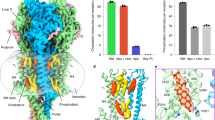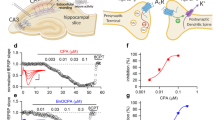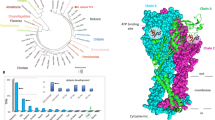Abstract
ATP is known to be released in association with acetylcholine at synapses in the vertebrate peripheral nervous system1–4. Exogenously applied ATP and its derivatives have been shown to reduce the release of acetylcholine5,6, so it has been postulated that ATP has a role in the modulation of transmitter secretion2,7. More recent results have suggested, however, that specific adenosine receptors are responsible for the inhibitory effects of adenosine derivatives on transmitter release, and ATP, if released, must be hydrolysed to adenosine to produce inhibition8–11. The original hypothesis that ATP itself might inhibit acetylcholine secretion would be strengthened if it were found that adenosine is very much less potent than ATP as an inhibitor of ACh secretion. We report here results which show this is the case in sympathetic ganglia.
This is a preview of subscription content, access via your institution
Access options
Subscribe to this journal
Receive 51 print issues and online access
$199.00 per year
only $3.90 per issue
Buy this article
- Purchase on Springer Link
- Instant access to full article PDF
Prices may be subject to local taxes which are calculated during checkout
Similar content being viewed by others
References
Silinsky, E. M. & Hubbard, J. I. Nature 243, 404–405 (1973).
Silinsky, E. M. J. Physiol., Lond. 247, 145–162 (1975).
Zimmerman, H. Neurosciences 3, 827–836 (1978).
Israel, M. & Meunier, F. M. J. Physiol., Paris 74, 485–490 (1978).
Ginsborg, B. L. & Hirst, G. D. S. J. Physiol., Lond. 224, 629–645 (1972).
Ribeiro, J. A. & Walker, J. Br. J. Pharmac. 54, 213–218 (1975).
Ribeiro, J. A. J. theor. Biol. 80, 259–270 (1979).
De Mey, J., Burnstock, G. & Vanhoutte, P. M. Eur. J. Pharmac. 55, 401–405 (1979).
Silinsky, E. M. Br. J. Pharmac. 71, 191–194 (1980).
Stone, T. W. J. Physiol., Lond. 335, 591–608 (1983).
Moody, C. J. & Burnstock, G. Eur. J. Pharmac. 77, 1–9 (1982).
Blackman, J. G., Ginsborg, B. L. & Ray, C. J. Physiol. Lond. 167, 355–373 (1963).
Del Castillo, J. & Katz, B. J. Physiol., Lond. 124, 560–573 (1954).
Martin, A. R. Physiol. Rev. 46, 51–66 (1966).
Silinsky, E. M. J. Physiol., Lond. (in the press).
Akasu, T., Hirai, K. & Koketsu, K. in Physiology and Pharmacology of Adenosine Derivatives (eds Daly, J. W., Kuroda, Y., Phillis, J. W., Shimizu, H. & Ui, M.) 165–171 (Raven, New York, 1983).
Ginsborg, B. L. J. Pharmac. exp. Ther. 150, 216–219 (1965).
Author information
Authors and Affiliations
Rights and permissions
About this article
Cite this article
Silinsky, E., Ginsborg, B. Inhibition of acetylcholine release from preganglionic frog nerves by ATP but not adenosine. Nature 305, 327–328 (1983). https://doi.org/10.1038/305327a0
Received:
Accepted:
Issue Date:
DOI: https://doi.org/10.1038/305327a0
This article is cited by
-
P2 receptor-mediated modulation of neurotransmitter release—an update
Purinergic Signalling (2007)
-
The effect of nucleotides and adenosine on stimulus‐evoked glutamate release from rat brain cortical slices
British Journal of Pharmacology (2000)
-
Ecto-protein kinase activity on the external surface of neural cells
Nature (1986)
Comments
By submitting a comment you agree to abide by our Terms and Community Guidelines. If you find something abusive or that does not comply with our terms or guidelines please flag it as inappropriate.



